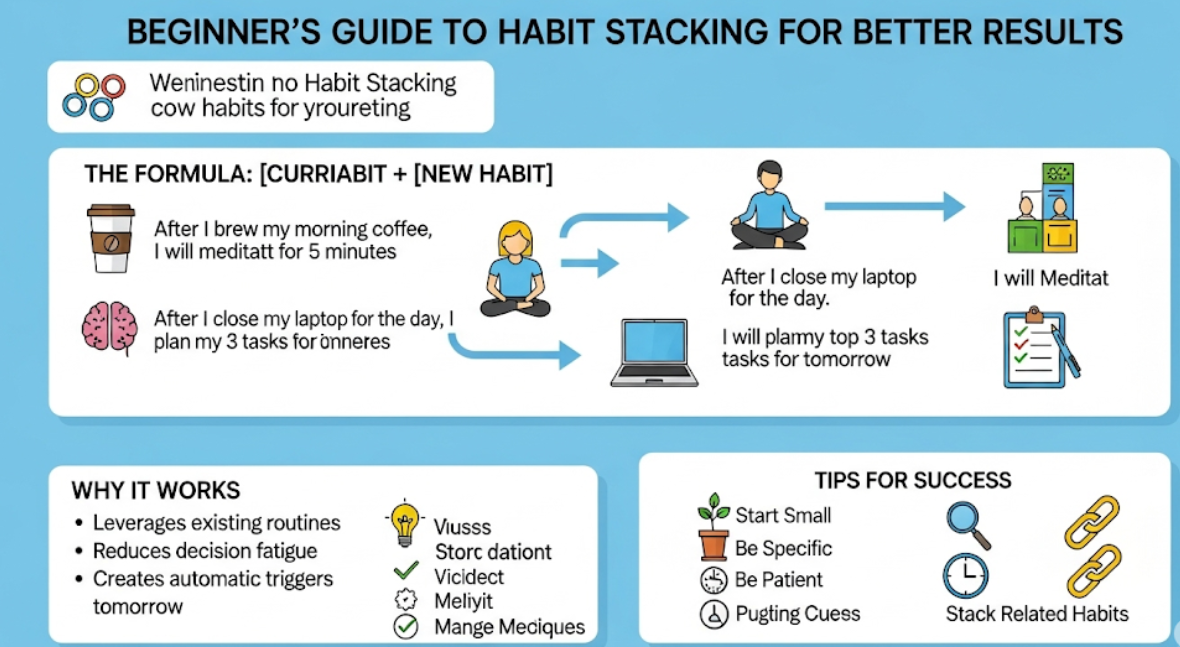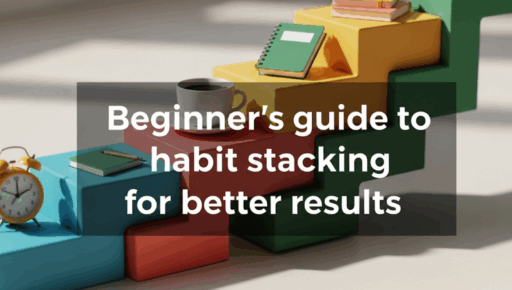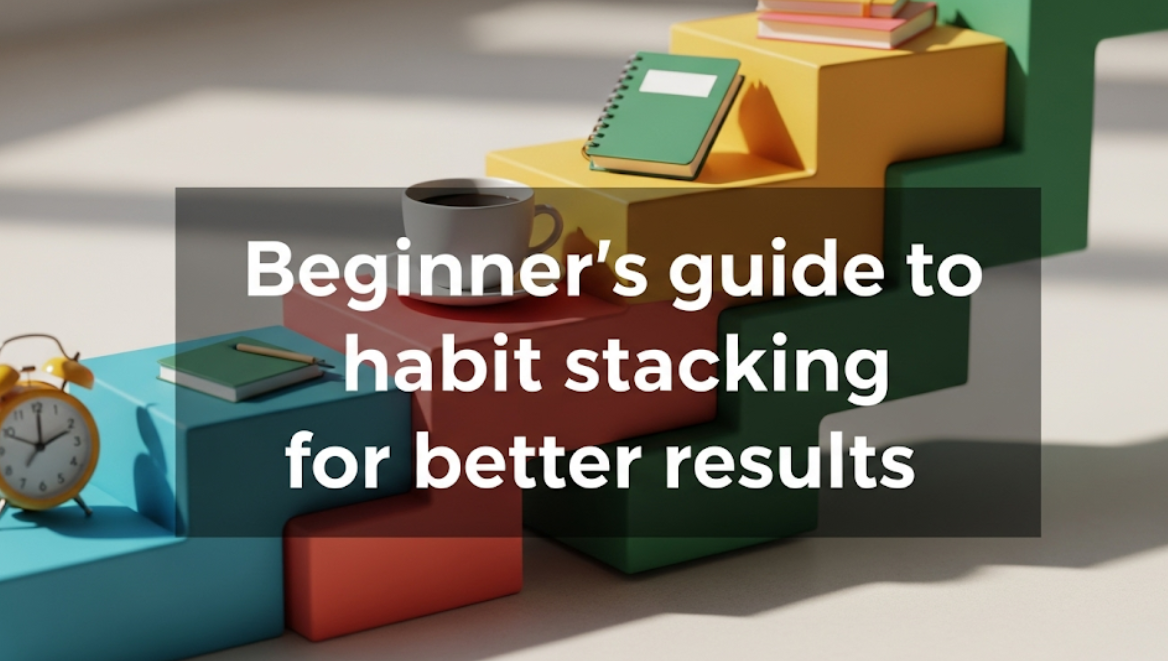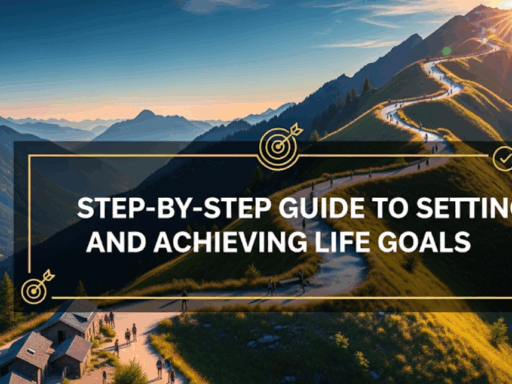Meta Description: Transform your life with habit stacking – the proven technique that links new behaviors to existing habits for effortless change. Learn the science-backed 7-step blueprint to build lasting habits in health, productivity, and personal growth. Start small, stack smart, and create automatic routines that stick permanently.
Habit Stacking: The Complete Guide For Beginners
Trying to build new habits can often be an insurmountable task. You know where you want to be, but you have no idea how to get there. What if there was a simple hack to make this trip easier? That’s where habit stacking comes in: it is a powerful routine integration technique for turning your existing habits into the springboard for new behaviors.
Habit stacking involves combining a new behavior or habit you want to incorporate into your life with an existing habit you do effortlessly. Instead of doing battle with the way your brain naturally functions, you harness it. This has resulted in millions of people being able to easily add habits such as exercise, meditation, and reading into their lives.
Here you will learn exactly what is habit stacking, why it works so well and MOST importantly how to use habit stacking in your own life to change the person you are. Whether it’s being healthier, getting more done or learning something new, habit stacking can be the key to that change you’ve been aiming for.
Why Is Habit Stacking So Effective?
Picture your mind as a heavily used network of highways. Certain roads are major highways — smooth, automatic and familiar paths (i.e., pre-existing habits). Other roads (new habits you are establishing) resemble verbose forest trails: hard, winding and demanding constant upkeep.
Habit stacking connects these dirt paths to your existing highways. You take the bumpy road instead of reminding yourself to do so, without a fault you simply end up following the path you have already blazed before.
The Science Behind the Magic
Your brain loves efficiency. As you continue a habit, neural pathways in your brain grow stronger with each repetition, making that behavior more and more automatic. This phenomenon is often called “neuroplasticity”, our brain’s amazing capacity to change through repeated experience.
You see, when you stack a new habit on top of old ones, what you are doing is borrowing the neural fortitude that is already in place with your established habits and using it to fuel a strengthening of the new one. This is what makes habit stacking seem so much more effortless than starting fresh on the second habit.
Real-World Success Stories
Example: Sarah, a high-spirited marketing executive, wanted to start journaling but just always forgot. She set phone reminders, and put her journal on a nightstand where she would see it when she went to bed, and asked her husband to remind her. Nothing worked consistently.
Then she discovered habit stacking. This is great since Sarah already had a good solid habit of sitting down first thing with her coffee and checking her emails. Thus, when it came time for Sarah to pick a new habit, she chose journaling but decided to pair it with a previously-established routine: “After I pour my morning coffee, I will write down three things that I am grateful for in my journal.”
Two weeks in, and journaling was as habitual as her morning coffee. It was seizing on an already formed habit to bring the new one along for the ride.
How The Habit Loop Works In Your Brain
Understanding how habits form in your brain — but let us first break down the practical steps of habit stacking. That knowledge will allow you to create habits that stick, and endure.
The Three-Part Habit Loop
Each habit follows this simple three-step pattern:
Cue: The trigger that tells your brain to start the habit
Routine (Behavior): The actual habit or behavior you carry out
Reward: The positive reception or outcome you have when you complete the habit
For example, brushing your teeth:
- Cue: The feeling of grittiness in your mouth when you wake up
- Routine: 2 minute teeth brushing routine
- Reward: Your mouth will taste fresh and clean
Why Most Habit-Building Attempts Fail
The majority concentrate on the routine, on behavior exclusively when attempting to build a habit. They think, “I just have to exercise every day,” not considering the cue or the reward.
This fails because it’s attacking the nature of how your brain works. If you do not have a cue, the habit will be forgotten. However, if the reward does not satisfy the brain — it will likely never be repeated again as your brain is oriented to avoid discomfort.
Habit stacking works because it creates a clear prompt (your current habit) and often increases the reward by causing you to feel successful doing two habits simultaneously.
One Simple Little Formula That Makes All the Difference
The formula for habit stacking is simple:
“After I [EXISTING HABIT], I will [NEW HABIT].”
The formula above packs a deceptive punch as it:
- Gives a cue (your current habit)
- Creates a roadmap for the new habit
- Decides when to do the new habit
- Leverages the neural pathways in your brain
Choosing the Right Anchor Habit
You would not want to stack with all existing habits. The best anchor habits are:
- Highly consistent (you do it every single day no matter what)
- Specific in timing (they occur at roughly the same time each day)
- Immediately obvious (there is no ambiguity as to when they’re finished)
Strong Anchor Habits – These are some examples of habits I have seen to be strong anchors:
- Your first pour from the coffee machine
- Starting work at your desk
- Charging the cell phone at night
- Washing your hands before meals
- As you sit in your vehicle to go back home
Examples of Effective Habit Stacks
Here are some habit stacks from the real-world that have been implemented successfully by thousands of people:
Health and Fitness Stacks:
- “When I make my morning coffee, I will complete 10 push-ups.”
- “After I put on my workout clothes, I will exercise for at least 2 minutes.”
- “After I finish lunch, I will eat one piece of fruit.”
Productivity Stacks:
- “Once I open my laptop, I will jot down my top three tasks of the day.”
- “After I finish checking my morning emails, I will put in 25 minutes on my most important project.”
- “After I finish dinner, I will plan tomorrow’s schedule.”
Personal Development Stacks:
- “When I climb into bed, I will read for 10 minutes.”
- “After I turn the key to start my car, I will listen to an educational podcast.”
- “When I get out of the shower, I will name three great things from my day and practice gratitude.”
Your Step-by-Step Habit Stacking Blueprint
How to Create Your First Habit Stack: This is the proven 7-step process that has personally helped thousands of people to successfully install new habits.
Step #1: Map Your Current Daily Routine
You have to visualize your current habits before you can layer on new ones. When you wake up in the morning, spend one day writing down everything you do automatically until you go to bed.
You might make your list similar to this one:
Morning Routine:
- Wake up and check phone
- Get out of bed
- Use the bathroom
- Brush teeth
- Take shower
- Get dressed
- Make coffee
- Eat breakfast
- Check emails
- Leave for work
Evening Routine:
- Arrive home from work
- Change clothes
- Eat dinner
- Watch TV
- Brush teeth
- Get into bed
- Set alarm
- Go to sleep
It’s important to not pass judgment on your current habits — just be a neutral observer of them and document the reality. This will be your base to stack new habits on.
Step 2: Find Your Most Powerful Anchor Points
Go back and look at your routine map and circle the habits that are:
- 100% Consistent (you are doing them every day, daily)
- Specific — clear start/end
- Time and Location Specific
These circled habits are your potential stacking anchors.
Step 3: Pick One Tiny New Habit
This is where most people mess up. They stack giant, complicated habits like “workout for an hour” or “read for 30 minutes.” Start small — ridiculously small.
Good starter habits:
- Do one push-up
- Read one page
- Write 1 sentence in a journal
- Drink one glass of water
- Take three deep breaths
- Organize one thing on your desk
The idea is to have high levels of consistency, not intensity. Make your habit bigger if you want, but only after it is a casual behavior.
Step 4: Write Your Habit Stack Equation
Write your actual habit stack with the formula: After I [EXISTING HABIT], I will [NEW HABIT]
For example:
- “After I pour my morning coffee, I will write one sentence in my gratitude journal.”
- “After I sit down at my desk to start work, I will take 1 minute to deep breathe.”
- “After I plug my phone in to charge at night, I will set out my clothes for tomorrow.”
Step 5: Test and Tune Your Stack
Now just take action implementing your habit stack. Just get this thing locked in for a week. Never mind perfect, only do the habit when your anchor habit occurs.
Pay attention to:
- Does the timing feel natural?
- Is the new habit too big or too small?
- What factors are standing in the way of smooth execution?
Make adjustments as needed. If you feel it is too large, make it smaller. Change the anchor habit if it does not make sense timing-wise.
Step 6: Track Your Progress
Implement a simple tracking system to follow along with your habit stack. This could be:
- Simple calendar where you place an X by each successful day
- A habit tracking app on your phone
- A notebook with checkmarks
Tracking will help you see how well you are doing and provides additional motivation to not break your chain.
Step 7: Build This Stack Over Time
When your first habit stack feels totally natural (2-4 weeks), you will move on to either:
- Scale the habit you have (one push-up becomes five)
- String together a second habit — to make that chain longer
- Create a new habit stack with another anchor habit
Quick note: small changes are better than huge overhauls all the time.
Advanced Strategies for Maximum Results
After becoming fluent with habit stacking, these advanced approaches can help you create habits that will be more powerful and last longer.
The Sandwich Method
Insight: Rather than stacking a new habit on top of an old one, build practice sessions into the sandwiched space between two existing habits.
As an example: “After I pour my coffee in the morning and before I check my emails, I will journal for 5 minutes.”
This further solidifies the neural connection, as your new habit is now supported not only by your original habit but by two habits.
Environmental Design
Design your environment to make it simpler for you to habit stack. This might involve:
- Standing your journal by the coffee maker
- Laying out your workout gear the night before
- Using a book as your pillow so you have to see it when you lay down for the night
The Two-Minute Rule
Each habit you want to stack should involve a task or behavior which takes less than 2 minutes to carry out. This maintains a ridiculously low barrier to entry and reduces overwhelm.
If it will take more than two minutes, break down your habit like this:
- Want to exercise? Start by putting on your workout shoes.
- Want to meditate? Begin by sitting in your meditation position for 1 minute.
- Want to learn guitar? Pick up your guitar and play one chord.
Stack Multiple Habits Together
As your habit stacks change from a series of individual things to more automatic longer chains:
“After I wake up, I will make my bed. After I make my bed, I will do 10 jumping jacks. After I finish doing jumping jacks, I will have a glass of water.”
Build slowly to chains of 2–3 habits at most.
Common Mistakes That Sabotage Success
Try not to spend the weeks I did figuring out what NOT to do! The biggest habit stacking mistakes and how to avoid them:
Mistake 1: Starting Too Big
The Problem: One of the easiest ways to give up on any habit is by stacking major habits like “exercise for 45 minutes” or “read for an hour.”
The Solution: Always start with the smallest possible version of your desired habit.
Mistake 2: Selecting Weak Anchor Habits
The Problem: Choosing anchor habits that are fuzzy or aren’t 100% consistent.
The Solution: Pick only those habits that you always do and which have clear start & stop points.
Mistake 3: Ignoring Environmental Context
The Problem: Inappropriate habit stacking timing or location.
The Solution: Choose a new habit that is a logical extension of established and regular behavior.
Mistake 4: Perfectionism Paralysis
The Problem: Believing you have to perform your habit stack flawlessly every day.
The Solution: Focus more on showing up consistently — consistency is more important than perfection.
Mistake 5: No Clear Trigger
The Problem: Vague habit stacks like “After I eat lunch, I’ll be more productive.”
The Solution: Be specific about both the anchor and the new habit.

Troubleshooting Your Habit Stacks
The cold hard truth is that, even with perfect planning, you will sometimes have issues with your habit stacks. The following are common issues and their respective solutions.
When You Keep Forgetting
What if you always forget to do your new habit after your anchor habit?
Solutions:
- Create visual cues in your environment
- Improve your mental habit stack by mentally rehearsing the sequence
- Find a more robust anchor: Choose a stronger, repeatable, and observable anchor habit
- Eliminate friction: Lower the barrier to start with a mini-habit
When Motivation Disappears
While motivation ebbs and flows, your habit stack should not:
Solutions:
- Focus on systems, not outcomes
- Make it fun: Include music, have someone practice with you, or give yourself a reward afterwards
- Recall your why: Reconnect with the underlying motivations for why you wanted this habit
- Lower the standard: Shrink the habit so you can maintain it for at least 2 minutes consistently
When Life Gets Busy
Keep your habit stacks alive in rough times by:
Solutions:
- Scale down: Many days you can cope with just a small part of the habit itself
- Safeguard your anchor habits: These are lifelines during stormy times
- Stay flexible with timing: Let your stacks float around while keeping the sequence
- Plan for resilience: Recognize predictable disruptions and create plans to tackle them
When Progress Feels Slow
Habit formation is like compound interest — the benefits of good habits multiply and amplify over time:
Solutions:
- Recognize progress: Celebrate successful days and small signs of progress
- Focus on identity: You are the type of person who does this habit
- Be patient: It takes 18–254 days to form a habit — average is 66 days
- Track what matters: Measure consistency, not only results
Long-Term Success Strategies
Habit stacking is just one habit stack. Learn how to create profound, lasting change in your life.
Creating Theme-Based Stacks
Create habit stacks around themes of your life:
Health Theme:
- Morning: “After I wake up, I will drink a glass of water”
- Afternoon: “After I finish eating lunch, I will go for a 5-minute walk”
- Night: “After I put on home clothes, I will do 10 squats”
Learning Theme:
- “Before I turn on my car, I will listen to an educational podcast”
- “After I finish dinner, I will read for 10 minutes”
- “When I go to bed, I will review what I studied today”
The Seasons of Habit Stacking
While you may want to shift your focus to different types of habits during the seasons:
- Spring: Health and fitness habits
- Summer: Social and relationship habits
- Fall: Learning and skill-building habits
- Winter: Reflection and planning habits
That way you do not get overwhelmed and are able to consistently grow throughout the year.
Building Your Personal Operating System
Over time, your habit stacks come together and form what productivity gurus call your “personal operating system” — the set of automatic habits that continuously draw you closer to where you want to be.
Your morning habit stacks might ready you for the day — mind and body. Work habit stacks could mean increased productivity and focus. Evening habit stacks can help you wind down and reflect, leaving you refreshed to finish the day, recover from mistakes made during the day, and get prepared for tomorrow.
Sharing and Accountability
While habit stacking is a very personal thing, you can make yourself accountable by sharing your progress:
- Habit buddy: Sync up habits with a friend or family member
- Online community: Share progress and get feedback from others who are building habits
- Teaching others: One benefit is explaining habit stacking to others
- Family stacks: Establish household routines that help share positive habits
What To Do Next to Successfully Habit Stack
Now that you have all the tools, you can start to hack your daily routine with habit stacking. However, information without action is simply entertainment. Here’s what you need to do right now:
Today: Map out your current schedule of habits and identify three anchor behaviors
This week: Choose one small habit to stack with one anchor behavior and start implementing
Next month: Review your progress and possibly add a second stack
In 3 months: Assess the effects, look for improvements in habit stacking efficiency, and determine next steps in lifestyle design
Remember, the point is not to turn your life completely upside down overnight but to improve a little daily, which adds up over time. Every expert was once a beginner, and every transformation begins with one small step.
Your future habits have to be built today. Use the magic of habit stacking and you are not only changing what you do but most importantly who you become. She who always practices becomes fit. The one who reads often becomes educated. The person who practices gratitude becomes happy.
Take baby steps and have faith in the process. It all starts with your next habit stack.
Habit Stacking Pillars for Success
There are a few key rules to remember when beginning the practice of habit stacking:
Start Stupidly Small: You’ll be better off in the long run starting with one push-up a day than failing once a week trying to do 50 push-ups. Showing up every day is more important than showing off once in a while.
Anchor to Certainty: Only stack new habits on top of behaviors you already do 100% of the time.
Design The Environment: Change the environment in such a way that it makes good habits easy and bad habits nearly impossible.
Practice Patience: Everything worthwhile takes time and the smallest changes compound to something massive.
Adjust and Adapt: Make changes to a habit stack if it is not working, rather than removing the practice altogether.
A journey of a thousand miles starts with a single step. In the world of habit stacking, that one step is using your current habits to help form new habits. The extraordinary can be achieved from there — and is built on that small beginning.
What you do every day becomes your habits, your habits shape your days, and your days shape your life. When you master the art of habit stacking, you are taking control and creating your life by design.
The best time to start was yesterday. The second best time is today. Pick your first habit stack and start transforming now.




